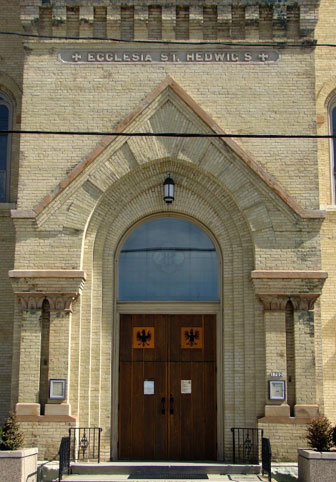16. St. Hedwig’s Catholic, 1886
Now Three Holy Women Catholic
1716 North Humboldt Avenue (at Brady Street)
Architect: Henry Messmer
St. Hedwig’s Catholic Church, with its steeple rising more than 160 feet above the sidewalk, marks the center of the Brady Street commercial corridor on the city’s Lower East Side. In the late nineteenth century, the surrounding blocks were largely settled by Polish immigrants who moved into the area to work in the tanneries and other industries along the Milwaukee River. Founded in 1871 as a Polish-language parish, St. Hedwig’s was the first daughter of St. Stanislaus Church, established five years earlier. Most of the Polish immigrants living in the vicinity of Brady Street had been members of St. Stanislaus on the South Side, but the distance of about three miles was inconvenient for attending religious services and impractical for schoolchildren.
The parish initially built a small church at Brady and Franklin Streets, at the opposite end of the block from the present church. The first Mass was celebrated on October 17 (the feast day of St. Hedwig) of 1871. That church served the parish for more than 15 years, with construction of the present church begun in 1886 and completed in 1887.
St. Hedwig’s is the oldest of three center-towered Romanesque Revival churches in Milwaukee. The other two are Saints Peter and Paul Catholic on the Upper East Side (built in 1890 and also designed by Henry Messmer) and St. Augustine of Hippo Catholic in Bay View (built in 1908). Three bells were installed in the tower of St. Hedwig’s in late 1887. A newspaper article at the time noted that the largest bell weighs more than 4,000 pounds. It is likely still one of the largest church bells in the city.
Comparing St. Hedwig’s to St. Hyacinth Catholic on the South Side illuminates a few of the sometimes-subtle differences between the classical styles and the Romanesque Revival. Both churches were designed by Henry Messmer and built in the 1880s. They are approximately the same size, with round-arch windows and doorways, and their towers are quite similar in their fenestration and in the forms of their steeples. St. Hyacinth has a pedimented front gable, with a lower roof pitch more like those of Greek and Roman temples. St. Hyacinth also has triangular pediments on the transept gables, above the central front entrance, and above most of the windows. In contrast, St. Hedwig’s has no pediments and lacks the prominent cornices that are seen on St. Hyacinth Church.
Alterations to St. Hedwig’s Church over the years have included replacement of the original gaslights with electric lighting, replacement of the wooden roof beams with steel beams, and new roof sheathing. In addition, the brick was cleaned and repointed in the 1960s, restoring the exterior to its original color.
Services at St. Hedwig’s were conducted entirely in Polish until the early 1930s, when some English-language services began. Services in Polish continued for three more decades, with the last sermon given in that language in 1962. In 2000, St. Hedwig’s and two nearby Catholic parishes consolidated to form Three Holy Women Parish. The other two churches that make up the new parish are Holy Rosary and St. Rita’s. Holy Rosary was established in the 1880s as a geographical parish with services in English, rather than a national parish for a particular immigrant group. Holy Rosary Church is approximately eight blocks to the northeast of St. Hedwig’s. St. Rita’s was established in 1933 as a national parish for Italian immigrants, who had been moving into the neighborhood since the early twentieth century and made the western portion of Brady Street a virtual “Little Italy” by the 1950s. St. Rita’s Church is just five blocks to the southwest of St. Hedwig’s. The consolidated parish maintains and continues to use all three churches.
Sources:
Historic Designation Study Report: Brady Street Historic District. City of Milwaukee, Department of City Development, 2001.
“Laid Corner Stone,” Milwaukee Sentinel, September 6, 1886, page 3, column 1.
“New Church Bells,” Milwaukee Sentinel, November 14, 1887, page 3, column 2.
St. Hedwig’s, Milwaukee, Wisconsin. Custombook, Inc., 1971.
“Will Build a $30,000 Church,” Milwaukee Sentinel, Feb. 19, 1886, page 3, column 3.

